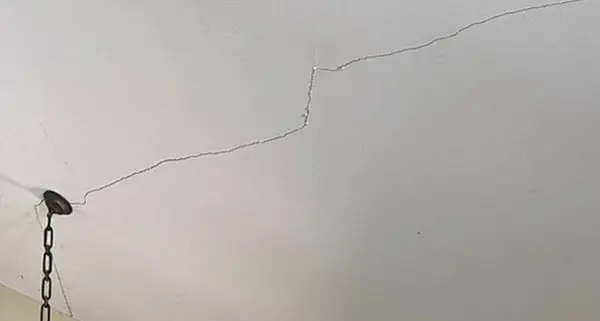Have you ever wondered, “What Causes a Crack in the Ceiling?” In this in-depth exploration, we’ll unravel the factors behind ceiling cracks, providing insights into their origins and offering practical solutions for prevention and repair.

Understanding the Dilemma: What Causes a Crack in the Ceiling
Ceiling cracks can be a source of concern for homeowners, signaling potential structural issues or environmental factors that need attention. Let’s delve into the various causes of cracks in the ceiling and understand how each factor contributes to this common problem.
Common Causes of Ceiling Cracks
- Settling and Foundation Issues: One of the primary causes of ceiling cracks is the natural settling of a building over time. As a house or structure settles into its foundation, stress can be exerted on the ceiling, resulting in cracks.
- Temperature and Humidity Fluctuations: Extreme temperature changes and fluctuations in humidity levels can cause materials in the ceiling to expand and contract. This continuous movement can lead to the development of cracks.
- Structural Movements: Structural movements, such as the shifting of load-bearing walls or the settling of support beams, can create stress points in the ceiling, leading to the formation of cracks.
- Water Damage: Roof, plumbing, or condensation leaks can infiltrate the ceiling, weakening its integrity and causing cracks. Water damage is a common contributor to ceiling issues.
- Poor Construction Practices: Subpar materials or improper installation during construction can lead to a compromised ceiling prone to cracking.
Addressing the Causes: What to Do About a Crack in the Ceiling
- Inspect and Assess: Begin by inspecting the crack to determine its severity and identify any potential underlying issues. Assess whether the crack is superficial or indicative of a more significant problem.
- Foundation Evaluation: If settling or foundation issues are suspected, consult with a structural engineer to evaluate the foundation. Addressing foundational concerns can prevent further damage to the ceiling.
- Temperature and Humidity Control: Implement measures to control indoor temperature and humidity levels. Proper insulation, ventilation, and the use of dehumidifiers can help minimize the impact of environmental fluctuations.
- Structural Repairs: If structural movements are identified, enlist the expertise of a contractor or structural engineer to assess and repair the underlying issues. This may involve reinforcing support beams or walls.
- Address Water Intrusion: Identify and repair sources of water intrusion promptly. Fix roof leaks, address plumbing issues, and ensure proper drainage to prevent ongoing water damage to the ceiling.
Read too: Understanding the Labor Cost to Texture Ceiling and Enhance Your Home: Unveiling the Secrets
Preventive Measures to Avoid Ceiling Cracks
- Proper Construction Practices: Ensure that construction work adheres to industry standards and uses quality materials. Proper installation and craftsmanship play a crucial role in preventing future ceiling issues.
- Regular Maintenance: Conduct regular inspections of the roof, plumbing, and other potential sources of water damage. Timely maintenance can help identify and address issues before they lead to cracks.
- Foundation Maintenance: Implement preventive measures for foundation maintenance, including proper grading for water runoff and avoiding overloading structural components.
Conclusion
Understanding what causes a crack in the ceiling is the first step towards effective prevention and resolution. Address settling and foundation issues, manage environmental factors, and implement preventive measures to proactively safeguard your home from potential hazards linked to ceiling cracks. By combining thorough inspections, targeted repairs, and ongoing maintenance, you can ensure the longevity and structural integrity of your ceiling, providing peace of mind for you and your family.